Text

"We prepare everything fresh from local ingredients," Abdu said, walking us around the Plant cafeteria. "We have grocers who bring us in-harvest vegetables and organic meats. The menu will change every week. So far, we've only used this cafeteria once. But, it is ready for when we open."

"I'm Tena Ezera Joas," the head chef said as she posed for her photograph. "I owned a high-class restaurant in Abebe Etefu. Abdu was actually a frequent patron."
We asked her how she felt about cooking for a larger population, and she laughed confidently. "The recipes are the same," she said, "It is just the quantities of ingredients that are different."
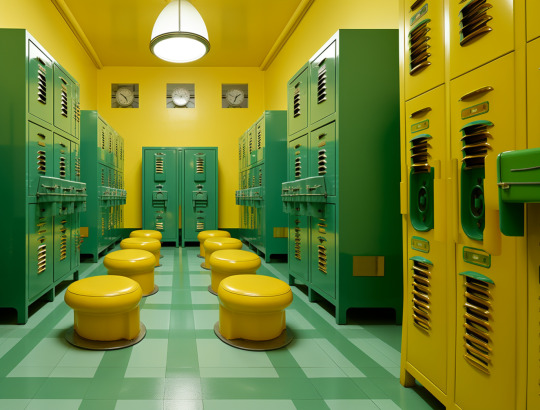

We toured the Plant locker rooms, including the wash stalls and wall-mounted showers. Everything was gleaming, fresh, and new.
Abdu led us down another hallway. "Now, a little more serious. I am taking you to see the decontamination area and the decontamination pods. These areas of the Plant were designed with the newest technologies in radiation suppression. Just do not turn on any of the nozzles."

We entered a long room that contained individual doors. "We decided not to do an open decontamination format. There is one pod for every staff member. So, you can imagine that there are a lot of pods. That is why we are glad that Wedefīti is a mile per side!"
"I am not supposed to do this," he continued, "but we still have time to re-sanitize the room before we open." He pressed a button outside one of the pods, and the lock hissed. Then, he opened the door so we could walk inside.

"The front area is for full-suit decontamination. The back is for skin decontamination. Technicians will leave their suits in the pod when they exit; the suits are cleaned as the pod undergoes its own sanitation. In the meantime, we will provide a new suit in the technician's locker."
We left the room, and the door hissed shut. "Come," he said, "I will take you to see the lab."

"Every Plant must have a good chemistry lab. The lab technicians have already been working for the last month. If you look to the right, you can see that they started by collecting samples of local flora. This is so we can start measuring the effects of Wedefīti on the local environment and make necessary changes."
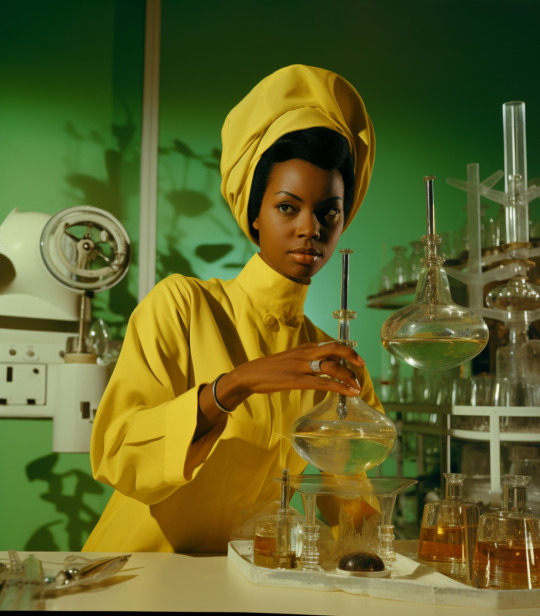


The chemists introduced themselves but were wary of our notebooks and watched carefully when we wrote things down. Pictured clockwise: Esyete Rada Befikadu, Helen Melku Gedarm, and Eyoab Goytom Atikem. Pictured below: Shashu Neguse Giday. None of the scientists would tell us the specifics of what they were doing, so we assumed they were working on the project Abdu had mentioned: radiation and local ecology.

Wes Anderson Power Plants is a work of fiction. All images are generated by AI.

#ai image#aiartcommunity#industrial#midjourney#nuclear power#nuclear#retromedia#retrowave#vintage aesthetic#wes anderson#wes anderson power plant#wes anderson power plants#science#chemistry#sciencecore#machinery#old computers#machine dreams#vintage#retro#retro futuristic#retro futurism#fiction#visual storytelling#ai#atomic#atomic era#scientists#laboratory#radiation
39 notes
·
View notes
Text

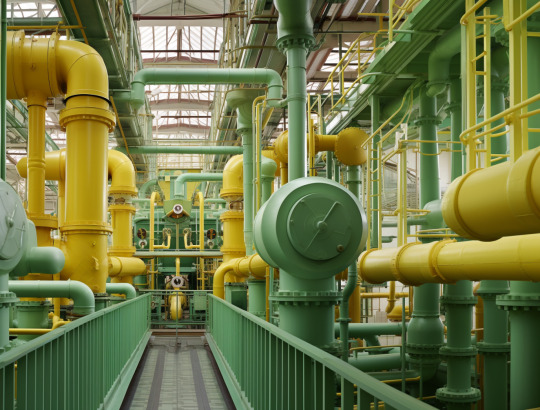


Abdu led us to several key rooms, proudly describing what the machines in each room did and who was meant to operate them.

Helina Abesalom Eba, Nuclear Technician.

Lia Addis Zemenfes, Mechanical Engineer.

Hezekiah Amha Tewodros, Radiation Safety Officer.


The Fuel Room and the Diesel Generator Room.
Pictured below are Safiyeh Eyasu Meles, Electrical Engineer, and Rashida Keya Bahta, Research Scientist.

Wes Anderson Power Plants is a work of fiction. All images are generated by AI.

#ai image#aiartcommunity#industrial#midjourney#nuclear#nuclear power#retromedia#retrowave#vintage aesthetic#wes anderson power plants#wes anderson#fashion#70s aesthetic#70s#retro futurism#retro futuristic#retro#vintage#atomic#atomic era#nuclear power plant#fiction#storytelling#visual storytelling#ai generated#ai#old computers#machine dreams#interior design#room decor
44 notes
·
View notes
Text

Our driver arrived early in the morning and took us out of the city to Wedefīti Nuclear Power Plant. When we got there, we took note of the site layout. Other Plants we'd seen had been in a more compact space, with the exception of Pathi. Wedefīti sprawled in both directions. "One side is one mile," Abdu had told us. We went inside.

Abdu was waiting for us in the lobby. He stood up when we entered and rushed over to shake our hands. "Welcome, welcome," he said. Then, he turned and gestured at the room. "Isn't it grand?"
We were impressed by the added decor, as if it were meant to make the engineers feel they were at a regular corporate office. It seemed odd that there would be a robust network of hallways, rooms, machines, and workers on the other side of the black doors.
"The three engineers I mentioned yesterday are busy with interviews, so they cannot attend," Abdu said, "However, if you're ready with your camera, I will take you inside the Plant to meet our staff."


Abdu led us down a long hallway. The double doors at the end of the hallway led into the Plant's control room, which still smelled of fresh paint.
"Our control room. We have a nickname for it: Mekīna, because it is like driving a car," Abdu laughed. "I must go talk with one of the attendants. Please feel free to walk around and take pictures."

The first person we met was a man named Ezkeiel Hassan Yitay, a Control Room Operator who chiefly managed the reactor control rods. He told us he had been working as a nuclear research scientist near Bahir Dar; Abdu had personally called him to offer him a position at Wedefīti. He immediately accepted.

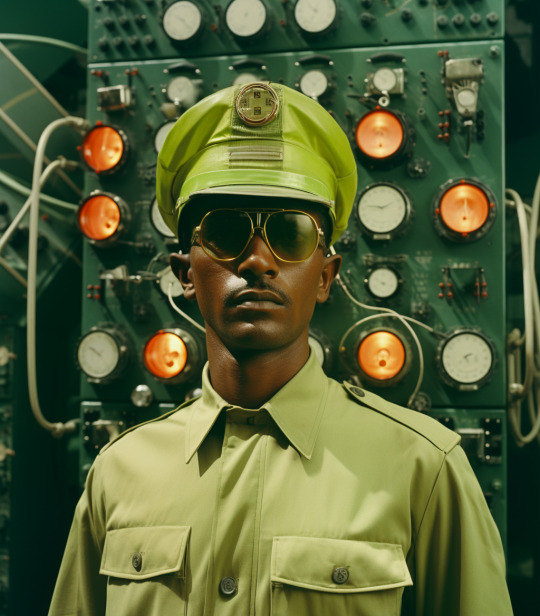



We moved around the room, taking portraits. The individuals pictured in the above five images are Andromeda Yitay Nega, Zeki Etefu Biru, Desta Alem Iskinder, Fassil Noab Biru, and Lielit Medr Armah. Pictured below is Control Room Operator Armani Yerga Demessie.

Wes Anderson Power Plants is a work of fiction. All images are generated by AI.

#ai image#aiartcommunity#industrial#midjourney#nuclear#nuclear power#retromedia#retrowave#vintage aesthetic#wes anderson power plants#70s aesthetic#70s#old computers#machine dreams#atomic era#atomic#nuclear power plant#visual storytelling#storytelling#fiction#retro futurism#retro#retro aesthetic#retro tech#retro futuristic#wes anderson#vintage#machinery#computers#ai generated
16 notes
·
View notes
Text
We left the Malabar Coast on an ocean liner named 'Surya' and sped through the Arabian Sea on our way to Ethiopia. We'd researched Merv's contact—a man working in Abebe Etefu, Ethiopia. After several phone calls, the man arranged for us to dock at Djibouti. Then, he would send a car to collect us.
The drive into Abebe Etefu was fascinating. From sparse landscapes grew a bustling city that had been built into the surrounding geological features. The driver brought us to a small downtown cafe where we had a standing meeting with Merv's contact, Abdu Senay Shale.

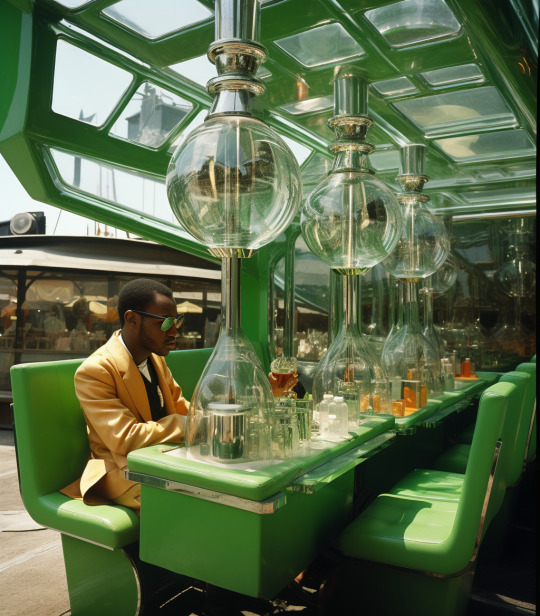
Abdu was already sitting on the cafe's patio when we arrived. We sat and ordered drinks, ready to talk about Wedefīti.

"It will be Ethiopia's first nuclear power plant," he declared. "It's groundbreaking. We wanted you here to document our opening day. The engineers and technicians have been on site for the last two months. We've all been preparing for this moment."
We felt honored that Abdu had chosen us and wondered what Merv had told him when he'd initially brought our team up in conversation.
Abdu placed several images on the table.
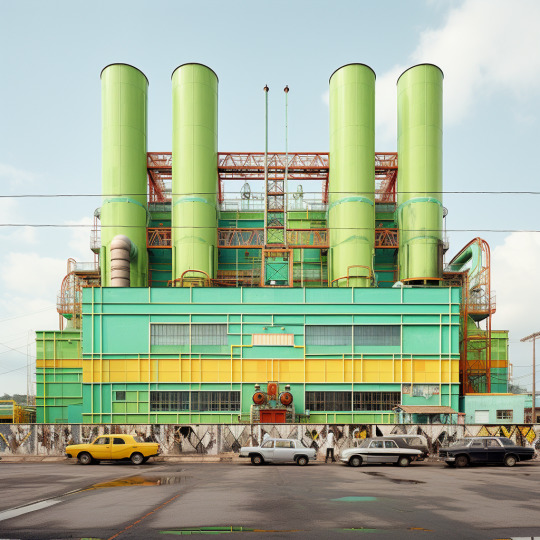



"We've been working on this project for years," Abdu continued. "Our staff is top-notch university talent from across the country. Safety is our priority, but so is doing everything 120%... We're the first, it has to exceed expectations."
"That there is Wedefīti. And a few of our top technicians: Nanni Trefe Kelile; Asnake Fekadu Hagos; Enku Tiruneh Bsrat. You will meet them tomorrow?"
We agreed to meet at Wedefīti the next morning; Abdu told us he would send a car to our hotel to take us to the outskirts of the city, where the nuclear power plant had been constructed.



Wes Anderson Power Plants is a work of fiction. All images are AI generated.

#ai image#aiartcommunity#industrial#midjourney#nuclear#nuclear power#retromedia#retrowave#vintage aesthetic#wes anderson power plant#wes anderson#atomic era#atomic#nuclear power plant#visual storytelling#fiction#old computers#retro style#retro futurism#retro futuristic#vintage#machine dreams#ai generated#storytelling#70s aesthetic#70s#vintage retro#retro aesthetic#afrofuturism#portrait
3 notes
·
View notes
Text
Instead of to her office, Lakshmi took us to her apartment. It was offsite, a few blocks away from the Plant. We gathered in her living room and she looked at us.

“I want you to write an article,” she said. Byron cleared his throat. “You’ve met the people here. You know the details you know. You can piece it together.”
We exchanged looks.
“Make it anonymous. Publish it after you leave. Avoid suspicion however you can. But, write the article. Do it for them.”
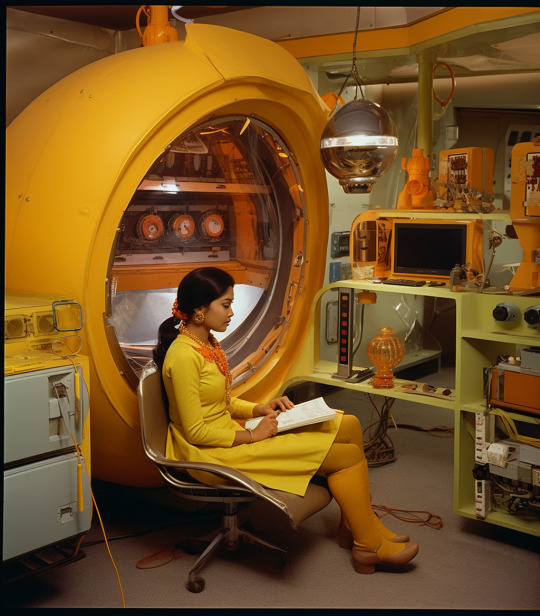

We left the Plant and returned to our hotel. There was a moment of weighted silence.
“Better start outlining the draft, Sport,” I said, looking at Byron.

“These came in the mail today,” Igor said, producing a slim envelope. I tore it open and unfolded a letter. Several images fell into my lap.


“I’ve got one for you, lads!” the letter began. Delia scoffed. “It’s from Merv. Hasn’t he been in Africa?”
The rest of the letter detailed Merv’s findings while on an archaeological dig. In the PS, however, Merv had written “have a contact at wedefīti. add to your list.”


Wes Anderson Power Plants is a work of fiction. All images are generated by AI.


#ai image#aiartcommunity#industrial#midjourney#nuclear#nuclear power#retromedia#retrowave#vintage aesthetic#wes anderson power plants#wes anderson#retro style#retro futurism#vintage#visual storytelling#storytelling#fiction#70s aesthetic#africa#atomic era#atomic#nuclear power plant#portrait#India#machine dreams#old computers#ai generated
12 notes
·
View notes
Text

Sona’s sister was waiting for us. We handed her the photograph and she stared at it for a long time.
“She was such an idiot… always had to be in the middle of things.” Sona’s sister said, “It’s about time someone came. I’m Rani.” She extended her hand and we all made our greetings.
“I… I have a question,” Byron asked. We were sitting on Rani’s yellow couch. “L-Lakshmi said that everyone here was an actor. Why was your sister even around the fi—”
“We all have some background in physics. Not expert-level, but some of us have worked for Universities. We were all actors who knew how to play the game on Easy Mode. Why not try to take it more seriously?”

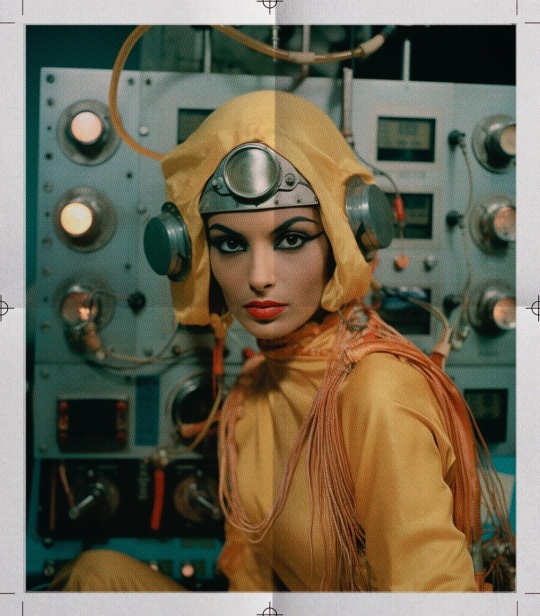

“…the fire changed everything, because it was real. Ex-professors tried to subdue the short-circuiting, and people like Sona jumped in to help. The firefighters were actors, just like us. Volunteer firemen from Diya. We found radiation gear and put on as much as we could, and then we just started turning on the soap and water to try and put out the fire…”
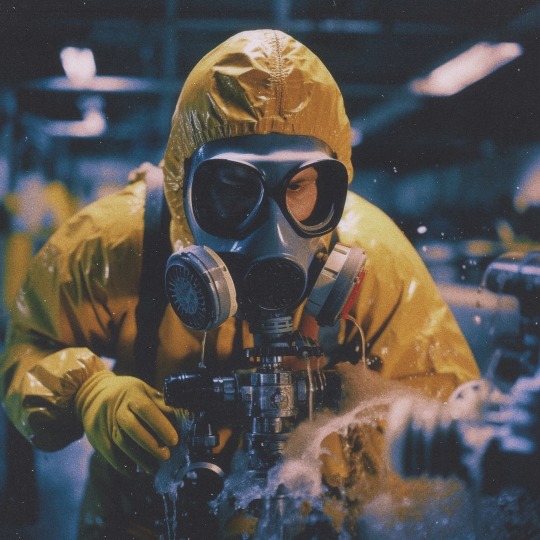
Rani sighed. “We felt like ants in an ant farm. Someone watching it all happen. We were asked to go to our apartments and await further instructions. Sona… was ki11ed by an electric shock when a live wire went into one of the decontamination puddles.”
We sat in silence.
“And now we’re here. And probably will be still, ‘til you’re long gone, and everyone else.”

We had 45 minutes until Lakshmi returned. We visited the other apartments on the list. Everyone was happy to see us. Despite this, Byron and Igor were overcome by an extreme melancholy. I could feel it, too. A spectre of a future gone.
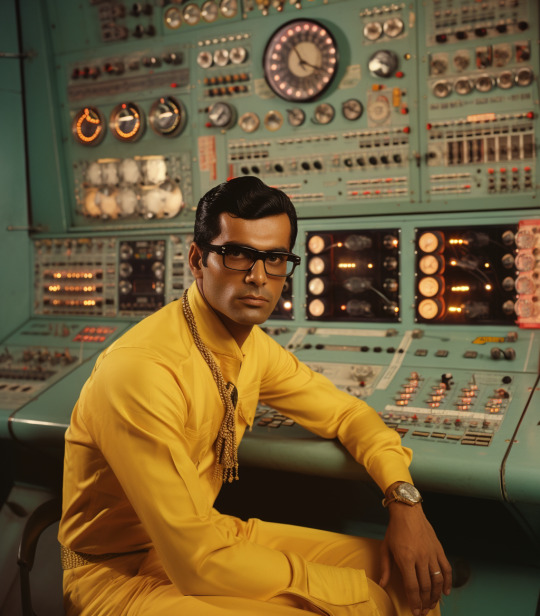
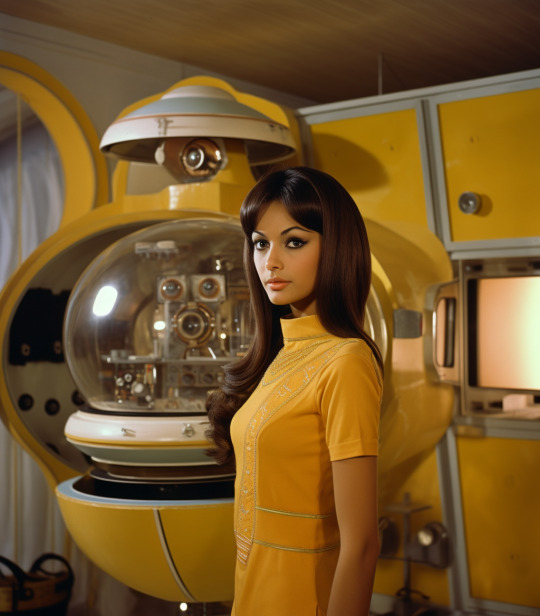
Wes Anderson Power Plants is a work of fiction. All images are generated by AI.


#ai image#aiartcommunity#industrial#midjourney#nuclear#nuclear power#retromedia#retrowave#vintage aesthetic#wes anderson power plants#wes anderson#nuclear power plant#storytelling#visual storytelling#fiction#retro futuristic#retro#retro futurism#futuristic#room porn#70s#70s aesthetic#ai generated
12 notes
·
View notes
Text
“What accident?”
Indira looked at us for a moment.
“You should go talk about it with Shivani,” she said, leading us back to the living room. “She’s in 301.” We thanked her and exited into the hallway. Indira’s door was sealed shut before us. 301 was on our list. We headed down the hall until we found the door. Again, Byron pressed the notify button on the console, and we waited.
After what seemed almost a minute too long, the door opened. We walked inside—the door shutting behind us. “Thank you for coming,” a woman said. She turned on the light.

We took a moment to glance around her tiny kitchen. I could sense that Byron wanted to look closely at the machines.
“Can you tell us about an accident?” Igor asked. We turned to look at him. He was usually silent. He coughed and looked toward Shivani. She laughed lightly and rolled her eyes.
“Don’t see anyone for years, and the first they ask is about the accident.”
We turned and looked at each other.
“It’s fine. I’ll tell you.”
We joined her at the kitchen table, and she passed a photograph in our direction.
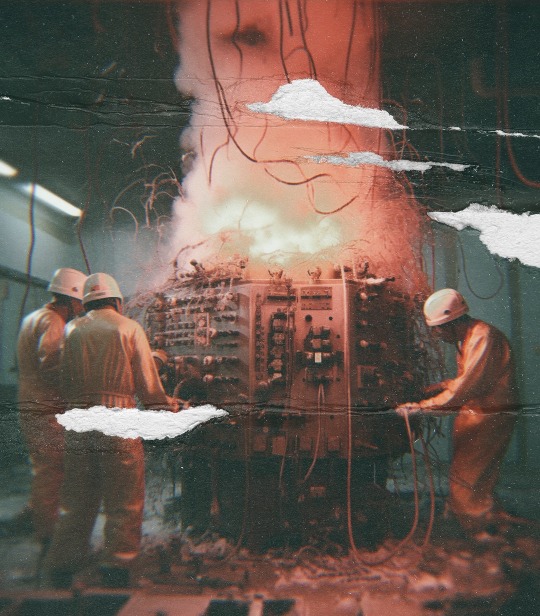
“I worked in the Filing Department. They asked us to destroy the pictures. I kept one.”
We examined it closely. “Before the Plant opened,” she continued, “They tried to install another reactor monitor outside of the reactor room. It caught fire. Somehow… we never really knew the reason why.”
“Why not?” Igor asked.
“They kept many documents from the engineers. A lot of things were destroyed. We were asked to stay here in the apartments after it happened.” She pushed three more wrinkled photographs across the table.

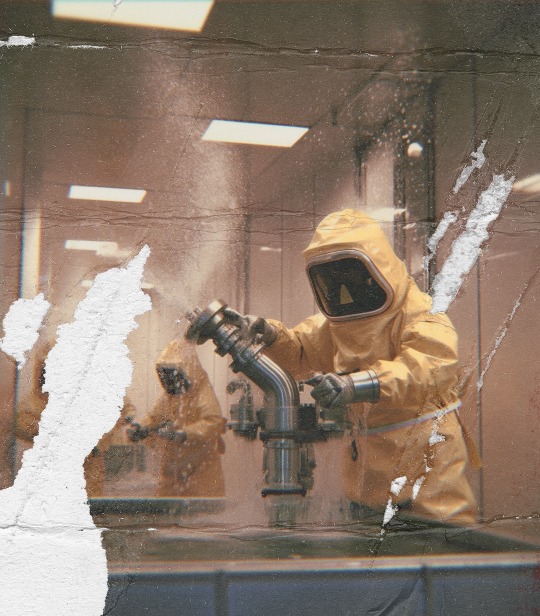

“Where did these come from?” we asked, passing the photographs between our group.
“The Filing Department,” Shivani said again and quickly pulled back the images. “Indira knows I have them. No one else. Two years ago, they told us five years. So, seven years. We’ve been here for ten. They won’t let us see our family members. We are decontaminated every week. But no one has a dosimeter to check what the levels actually are. I think they plan to keep us here.”
We stayed for coffee and then departed. From her doorway, Shivani watched us walk down the hall. She had a concerned look on her face.
Next, we knocked on door 221.
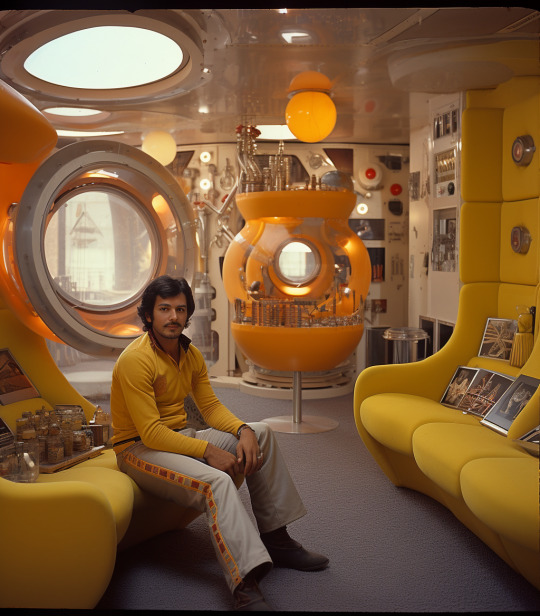
The apartment belonged to Jai, who had been present when the fire started. He’d laid out images of friends he’d lost in the accident before our arrival, and we were overcome by the emotion inside Jai’s space.
“We didn’t know how to put it out,” he said after a while. “And no one knows it even happened.” He took a shaky breath as we picked up one of the photographs.
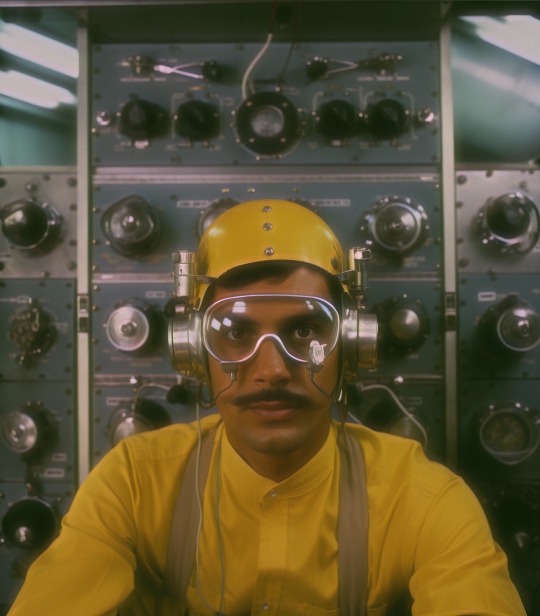

"That's Rakesh," he said, joining us at the side of the couch. "He always had jokes. We would pick on him because of his headset. He was supposed to be monitoring ambient radiation fields… He was with me, trying to fight the fire. It didn't matter. The other guy is Sandip. Probably the best physicist I've ever known."
We exchanged looks at the tragedy of the situation. These people, trapped within a recurring trauma, had been scrubbed from the public; a minor casualty in the eyes of those in charge but devastating to those it affected. "Too much talk," Jai said quietly, "And things start happening."
He handed us an unframed image. “That was Sona. Her sister lives in 165.”

Wes Anderson Power Plants is a work of fiction.
All images are generated by AI.

#ai image#aiartcommunity#industrial#midjourney#nuclear#nuclear power#retromedia#retrowave#vintage aesthetic#wes anderson power plants#atomic#atomic era#visual diary#wes anderson#retro futurism#retro futuristic#nuclear power plant#fiction#storytelling#India#70s aesthetic#retro#vintage#portrait#character ai
5 notes
·
View notes
Text
After two days, our hotel phone rang again. Lakshmi told us to get to Pahti as soon as possible; apparently, she had spoken with several residents of the Plant apartment building and they had encouraged her to invite us over. We made the journey back, found the entryway in the fence, and met Lakshmi outside.
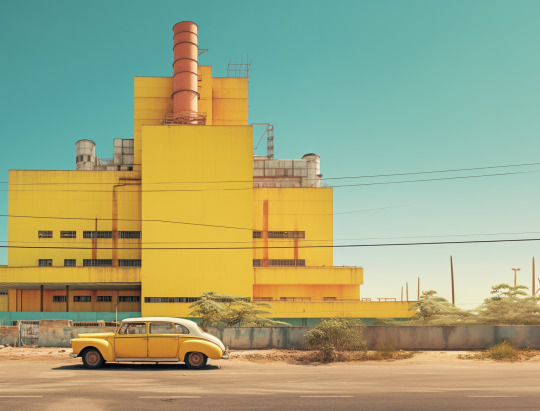
She was already in the driver’s seat, so we made a point to hop in quickly. There was a tension in the air as if we were going to be “found out.” Lakshmi started the engine and drove us across the site to the apartment building.
“They just completed a decontamination routine, so it is the safest time. Entry is not something that’s easily allowed. Residents have to fill out a mountain of paperwork before the Plant Administration even lets a family member in the door. The Administration doesn’t know you’re here.” She looked in her rear view window. There were no other cars around us.
We pulled up to the Pahti apartment building. We could only hear the wind. An eerie silence pervaded the scene. An old, rusted car and a produce truck were parked in front of the building. They were empty.

Lakshmi led us to the door and opened it. We realized she was not coming with us and asked why. “They’ll notice if I am gone for a long period of time during the day. Here is a list of apartments to see. I will be back to pick you up in two hours.” She closed the door behind us, and soon we heard the car engine start and then drift away.
At this point, we decided to formulate a plan. Lakshmi hadn’t told us the names of the apartment residents, just their door numbers. We assumed these were the people who wouldn’t mind our company and headed to the elevators.

We started with apartment 327. Byron cautiously pressed the “notify” button on the console outside of the air-locked door. Immediately we heard a hissing, and the door opened. A woman met us at the entry and waved us inside. The door sealed behind us.
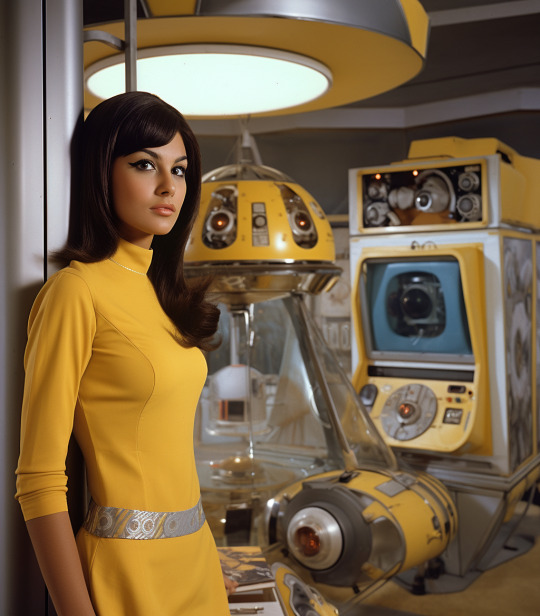
The woman turned on light music and brought us into the living room. “I don’t want them to hear,” she said quietly, glancing toward the radio. “My name is Indira.”
We thanked her for letting us into her home, which was small and full of machinery. “Are the other apartments like this too?” Byron asked, and Indira shrugged. “More or less. I wanted to meet you because I haven’t spoken to anyone but my neighbor in quite some time. I thought it might be nice.”
Indira showed us around her apartment and then pulled three photographs from a drawer. “These are some of the other interiors. We used to have parties more often. The neighbors all knew each other—even between floors. We liked visiting new apartments because they were always a little unique.”



We asked Indira why the parties had stopped, and she sighed. “People just started staying home more. After they told us it would be another five years at least… that was two years ago.”
“Why won’t they let you leave?” we asked.
She handed us two more pictures. “Because of the accident.”

Wes Anderson Power Plants is a work of fiction.
All images are generated by AI.

#ai image#aiartcommunity#industrial#midjourney#nuclear#nuclear power#retromedia#retrowave#vintage aesthetic#wes anderson power plants#wes anderson#atomic era#fiction#nuclear power plant#70s aesthetic#ai artwork#visual diary#retro futurism#retro#vintage#vintage retro#retro aesthetic#interior design#room decor#room design#storytelling
45 notes
·
View notes
Text
At 06:00, we reached Pahti Nuclear Power Plant and discovered that the site had been abandoned and gated off. A perimeter fence extended around the entirety of the Plant, leaving us scratching our heads. After an hour of searching, we found a makeshift doorway that had been cut into the fence. Cautiously, we walked inside. As we neared the Plant, Boyd started the tape recorder as instructed.
A woman met us at the door and ushered us inside, quickly closing the entrance behind her. The Plant was dark and musty. The woman led us to a side room that opened into a large, posh apartment. Another woman was sitting on an ottoman in the living room.

The seated woman identified herself as Lakshmi and thanked us for accepting her invitation. She then asked us to sit with her so we could speak quietly. We asked her about the state of Pahti—we hadn’t realized it had been inactive for so long. She told us that the Plant had never in fact been officially opened; a shock, to be sure.
We then asked about the images she had sent to Türkiye, and she pulled several more photographs from a small table. We took a moment to look them over.




Lakshmi revealed that the engineers and technicians were actually actors who had been hired to promote the opening of the Plant and paid to pose in uniform with the machinery.


We asked why so much effort had been put into the plant’s promotion when it had never actually opened. Lakshmi leaned close and said that Pahti had never received its official inspection—the directors kept delaying the process. For what, she couldn't tell; she mentioned that no one had been to the site in over ten years.

How did Lakshmi know all of these details? We asked about her credentials, and she would only tell us that she was related to someone who had invested in Pathi’s building. She had become fascinated by the actors, who now lived rent-free in the Plant’s engineering apartments on the condition they never left the perimeter. A small, contained community. Trucks would arrive weekly with fresh produce and supplies for the apartments’ 50-something residents.
Lakshmi produced more photographs—this time of the apartments—and told us that they were more recent. Some of the actors pictured still lived there. We asked if we could make contact with these individuals, and after a moment, Lakshmi said we should go back to our hotel for the next few days and wait for her call—then, she would take us to the apartment building. We took the photographs she offered us and left.

Wes Anderson Power Plants is a work of fiction.
All images are AI generated.

#ai image#aiartcommunity#industrial#midjourney#nuclear#nuclear power#retromedia#retrowave#vintage aesthetic#visual diary#india#70s aesthetic#atomic era#atomic#fiction#retro futurism#retro futuristic#retro#wes anderson power plants#wes anderson#portraiture#room decor#interior design#ai
17 notes
·
View notes
Text
Before we’d left Özlem, Byron received an unaddressed package at our doorstep. The return address read “Pahti Nuclear Power Plant.” Quick research turned up a Plant by the same name, which was located in the Indian state of Dunukepitiya on the Malabar Coast. The package contained several photographs and a note that we loosely translated—“Many more pictures for your research in India.”


We cataloged the images, though we had no identifying information for the engineers pictured. We also tried to find the name of the person who had sent the package, but we could only confirm a last name: Lakshmi.

We took the next flight out of Türkiye and settled in our hotel room in Dunukepitiya. After one day, we received a phone call from someone near the Pahti Nuclear Power Plant. Though they didn’t say their name, we assumed that this was the Lakshmi who had sent us the package in Özlem.
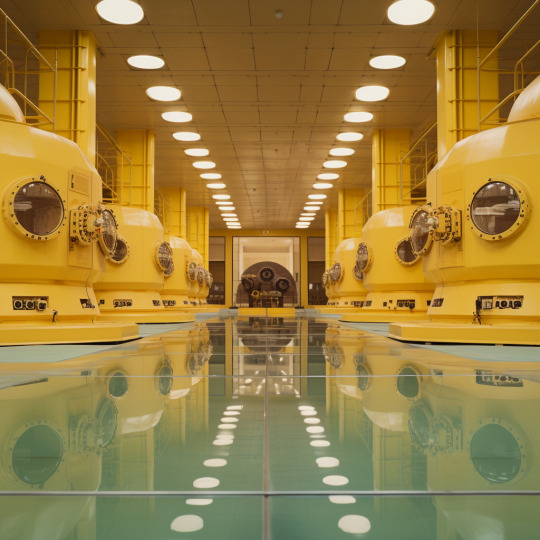
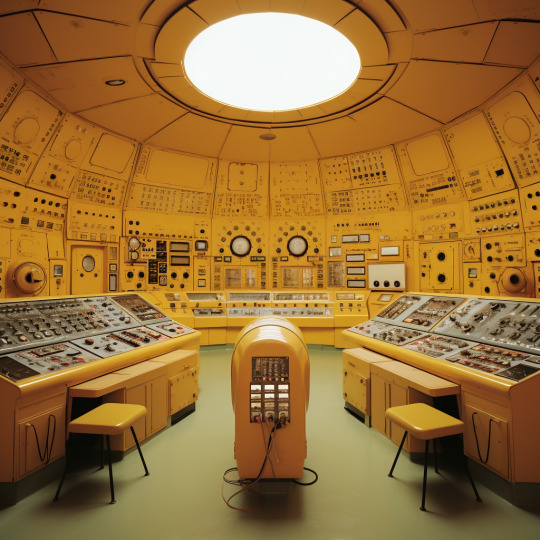
Over the phone, “Lakshmi” (or so we believed), invited us for a private tour of Pahti on the condition we only documented the images taken by our tour guide (or given, in the case of these photographs). We agreed to meet the following day.


Wes Anderson Power Plants is a work of fiction.
All images are generated by AI.

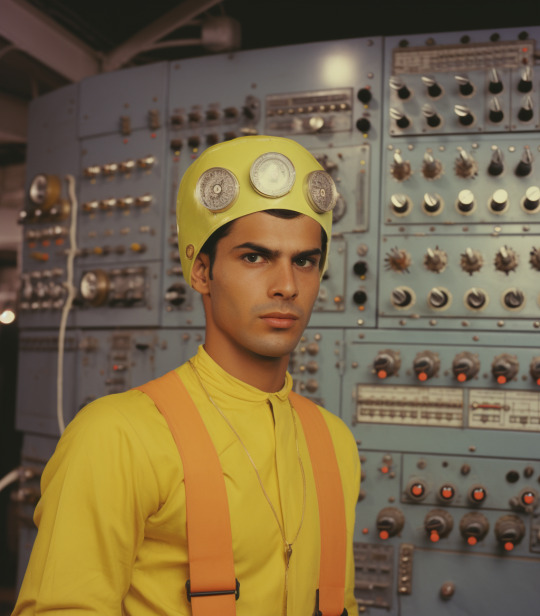

#wes anderson power plants#ai image#aiartcommunity#industrial#midjourney#nuclear#nuclear power#retro futuristic#retromedia#vintage aesthetic#retrowave#wes anderson#india#70s aesthetic#visual diary#vintage#ai art#ai artwork#fiction
6 notes
·
View notes
Text
Additional images from the Archives of the Özlem Plant’s apartment housing.



It is obvious the designers wanted to portray a stylistic yet functional apartment. Machines and monitors are uniquely disguised inside cabinets and faux furniture.



Reds, creams, leather, and industry.


Employees were provided clothing to wear during work and during leisure time at home. The apartment uniforms were specifically made to deter the effects of ambient radiation.

Wes Anderson Power Plants is a work of fiction.
All images generated by AI.

#wes anderson power plants#wes anderson#ai image#aiartcommunity#industrial#midjourney#nuclear#nuclear power#retro futuristic#retromedia#retrowave#vintage aesthetic#ai art#ai artwork#ai generated#fiction#atomic#atomic era#nuclear power plant#retro#retro futurism#vintage#70s aesthetic
86 notes
·
View notes
Text
Though on-base housing is typically seen at large Nuclear Power Plants, Özlem had its own apartment-style housing for all of its employees. Özlem is located in the town of Gökhan, about 50km from Istanbul. The population of Gökhan has been declining since the Plant’s closure; Özlem had been the largest job provider within a 20km radius. Keeping engineers and technicians housed on base allowed individuals to perform efficiently; however, due to shift scheduling, those living inside the Özlem apartments rarely left the Plant’s campus.

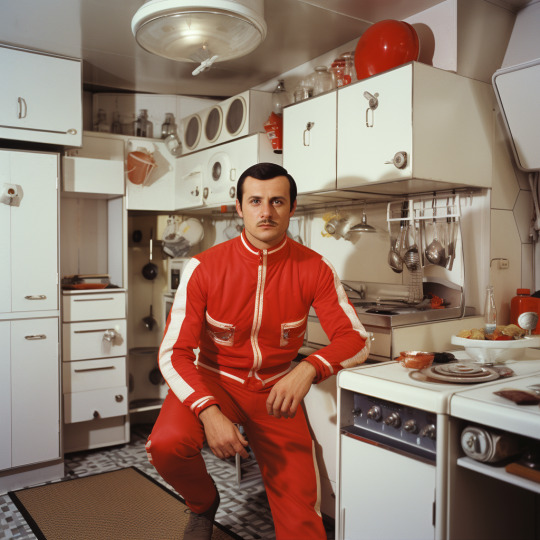
The apartments were decorated in the same color scheme as the Plant (red and white - the colors of the Turkish flag). Because of Özlem’s smaller employee load the apartments were larger than typical on-base housing. Builders focused on kitchens as the central hub of each apartment, hence the large amount of kitchen images from the Archives.



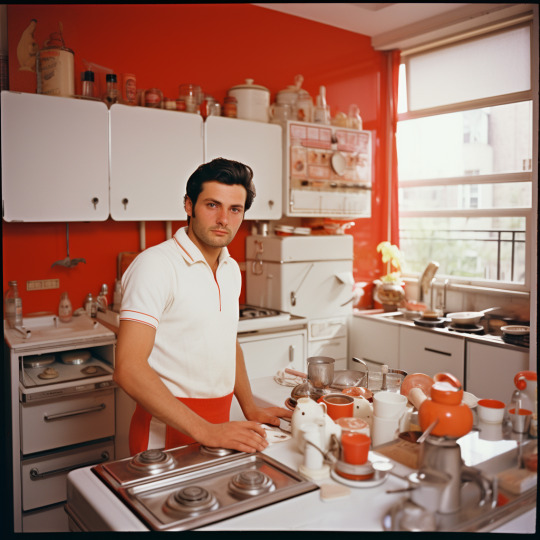
The apartments’ futuristic style allowed for the implementation of Plant machines so that engineers could monitor their work from home.
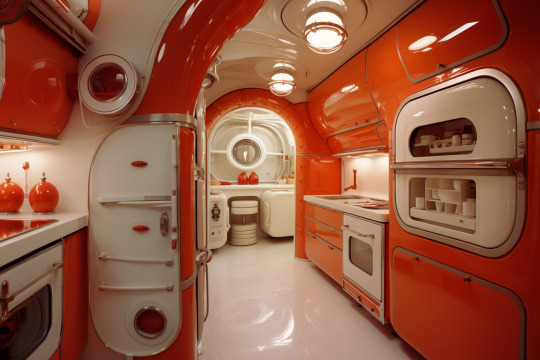


Wes Anderson Power Plants is a work of fiction. Images are generated by AI.
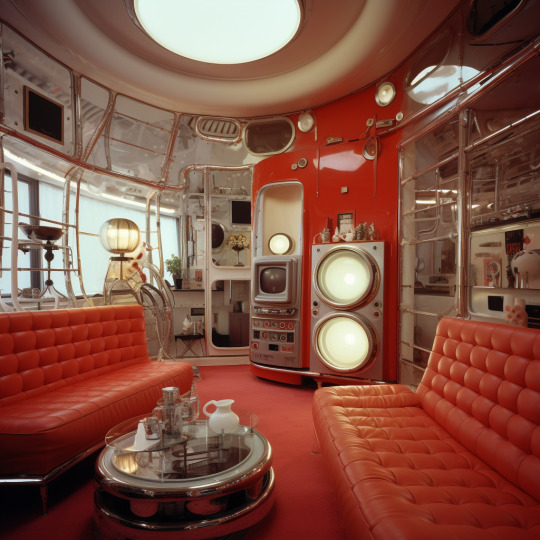
#ai image#aiartcommunity#industrial#midjourney#nuclear#nuclear power#retro futuristic#retrowave#retromedia#vintage aesthetic#wes anderson power plants#wes anderson#turkey#turkish#visual diary#atomic#atomic era#retro futurism#nuclear power plant#vintage#ai artwork#ai generated
14 notes
·
View notes
Text
As we studied the social, safety, and technical aspects of Özlem, we became fascinated by the Plant’s decontamination process. While many Plants notably deploy decontamination in wake of an emergency, Özlem required its engineers to complete a full decontamination before leaving the nuclear facility.


According to the Archives at Özlem, the decontamination rooms were busiest at shift changes; however, the rooms were designed to hold ~10 individuals at a time. Decontamination was often a lengthy process that involved two washes. To speed up the process, engineers controlled the sprayers and would decontaminate each other.




By ensuring all surfaces and engineers were decontaminated before leaving, Özlem maintained some of the highest safety standards of its time. No major radiation leaks or emergencies are recorded in the Archives.
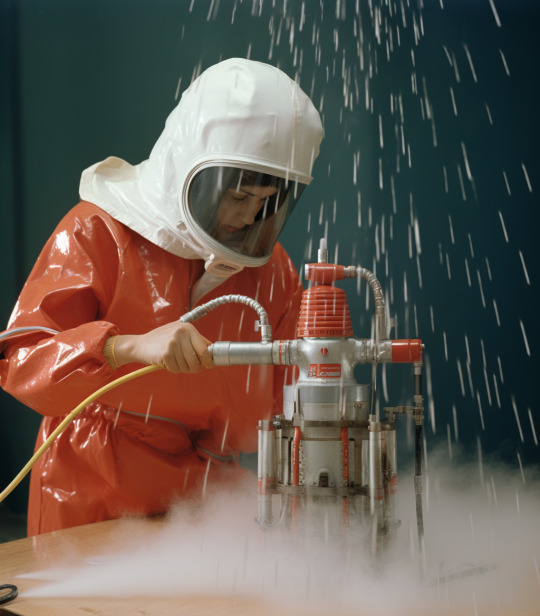


Wes Anderson Power Plants is a work of fiction. Images are generated by AI.

#aiartcommunity#ai image#industrial#midjourney#nuclear#nuclear power#retro futuristic#retromedia#retrowave#vintage aesthetic#nuclear power plant#wes anderson power plants#atomic era#retro style#retro futurism#radiation#ai generated#character ai#atomic
14 notes
·
View notes
Text






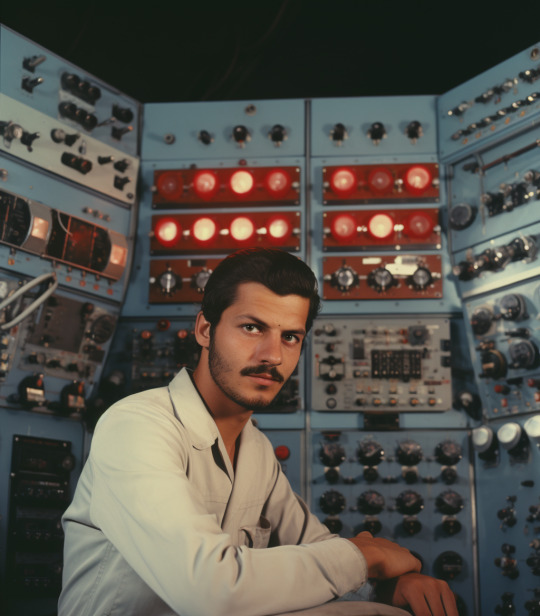

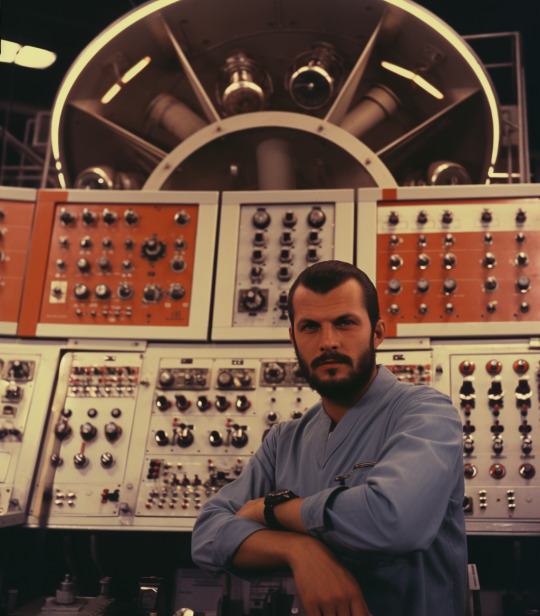

The next stop on our tour was Özlem in the Republic of Türkiye. The Plant was built in 1969. Now inactive, Özlem has been turned into a museum-of-sorts, with guided tours occurring daily. Our research showed that, despite its lack of nuclear operation, the Plant itself still carries ambient radiation. Those choosing to tour the plant must wear HazMat gear throughout their visit.
We spent a large portion of time in the Archives Room, which was situated away from the Control Room; though, we were not required to wear HazMat suits. Since the tour, our assistant researcher, Byron, has developed a small rash on his neck, but we’ve attributed this to bug bites rather than radiation poisoning.
Pictured here are several engineers and technicians whose portraits were taken several months before the Plant shut down operations. Collectively, the engineers called themselves “Bekçiler,” or “The Watchmen.” Özlem employed less than 200 technicians and engineers; the Plant itself had one reactor and produced about .5 gigawatts of energy.
AI ART - FICTION
#wes anderson#ai art#ai artwork#ai art gallery#ai art community#worldbuilding#retromedia#retro futurism#midjourney#wes anderson power plants#industrial#atomic#atomic era#portrait#architecture#interior design#room decor#visual diary#retrowave#vintage aesthetic#nuclear power#nuclear power plant#nuclear#turkey#turkish#turkiye
7 notes
·
View notes
Text
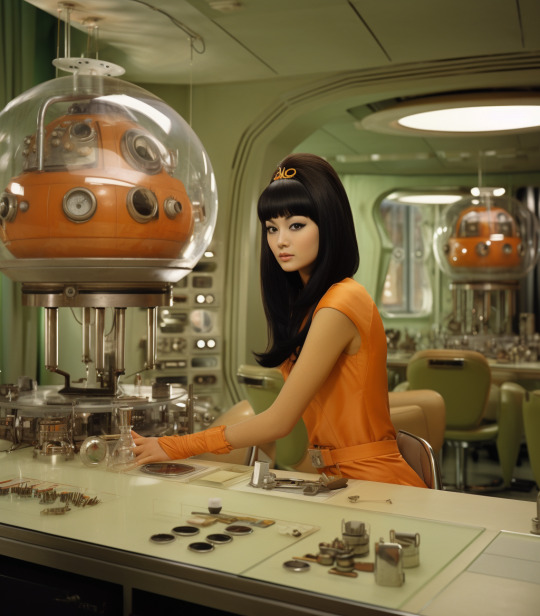

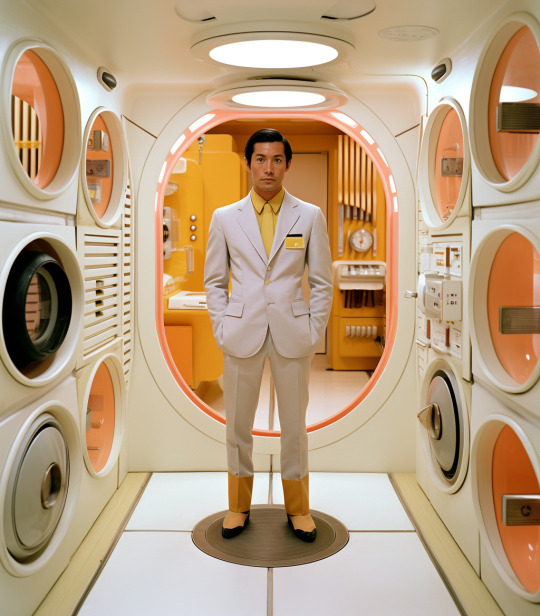
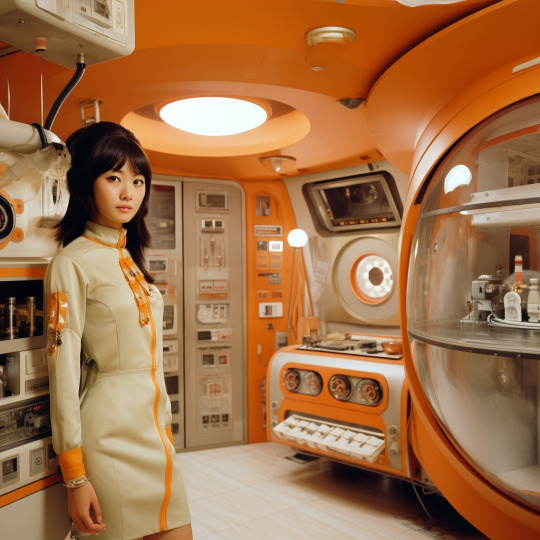

The portraits Onoda gathered not only show the varied interior designs in the Plant’s apartments, but also their inhabitants. We chose to publish a select gallery because we were unable to find the contact information for many of the residents. Onoda interpreted this as the Obara Nori maintaining privacy even after the apartments had shut down.

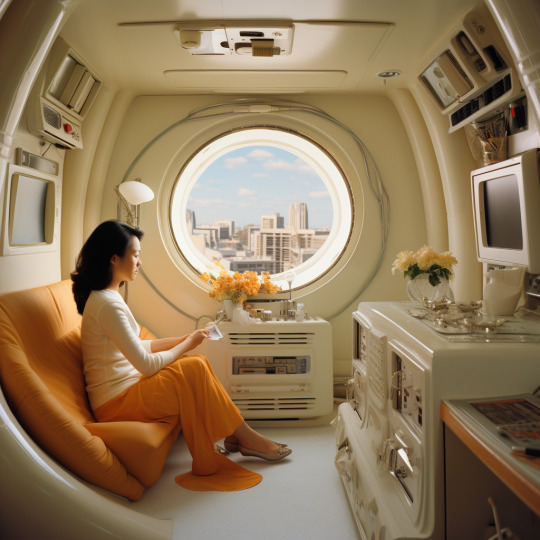

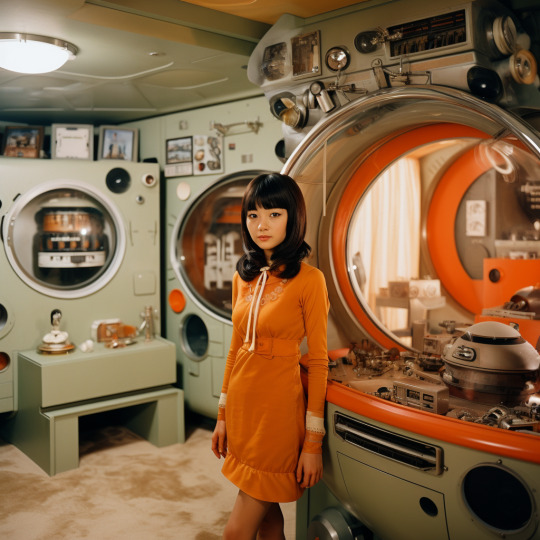
#wes anderson#ai image#ai artwork#aiartcommunity#worldbuilding#retromedia#retro futurism#midjourney#Wes Anderson power plants#industrial#atomic#atomic era#portrait#architecture#interior design#roomdecor#visual diary#retrowave#vintage aesthetic#nuclear power#nuclear power plant#nuclear#japan#japanese
866 notes
·
View notes
Text



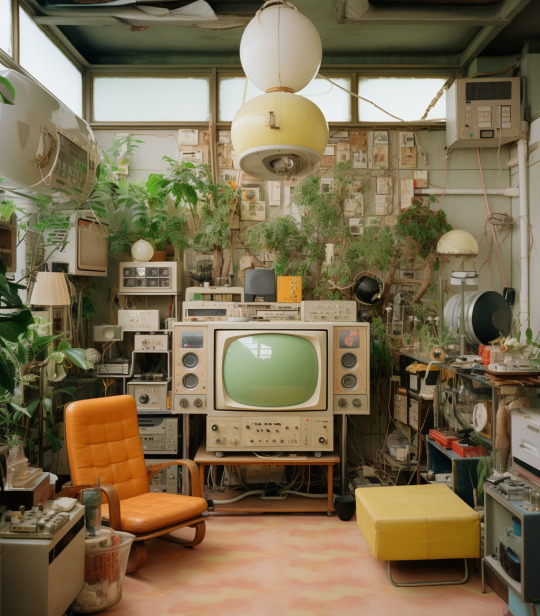

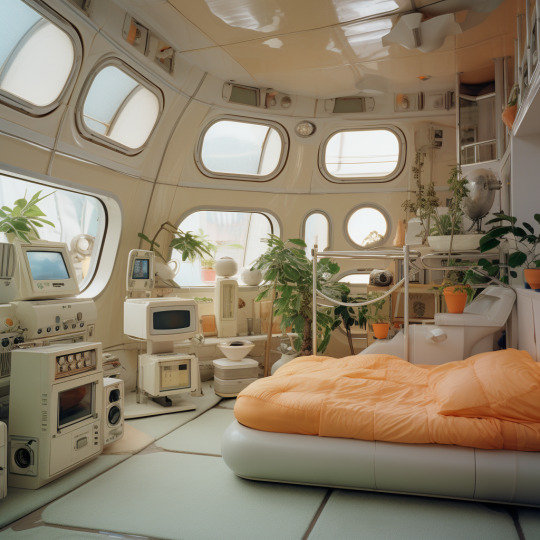
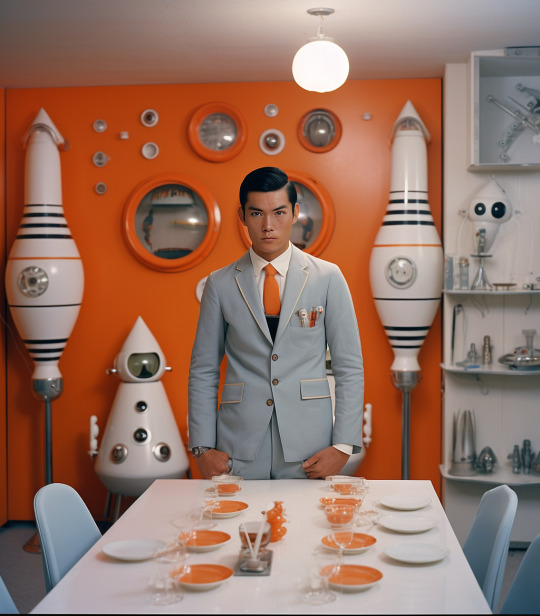


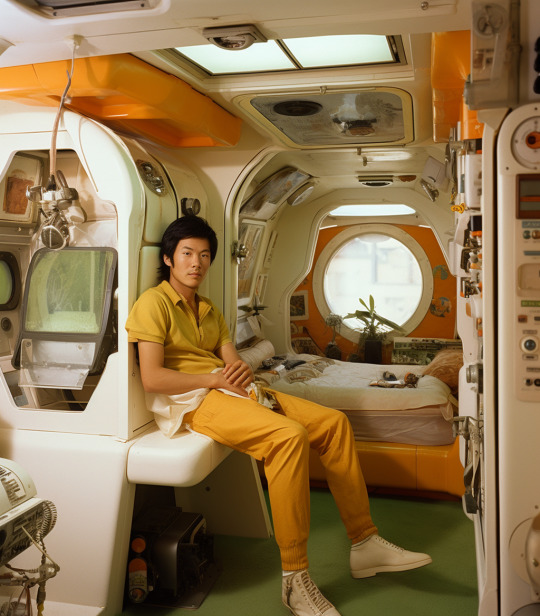
The Obara Nori Nuclear Power Plant was known for its balanced emphasis on work and leisure. All engineers, operators, and technicians lived on-base in barrack-like apartment housing. These apartments were outfitted with machinery that was linked directly to the reactor control room, the steam turbine room, and other necessary Plant systems.
Perhaps we can label Obara Nori as the first true "hybrid" work setting, as the engineers were able to work from their apartments one day per week. Because of the on-base apartments, shifts at Obara Nori were long—typically 12 hours on and 12 hours off. Engineers were encouraged to return to their apartments as soon as their work shift ended for extended rest, dining, and relaxation.
All engineers received access to a fully-decorated on-base apartment that would remain theirs for the duration of their employment. The apartments were single units, with women staying on the north side of the barracks. Couples were allowed to house together; Obara Nori allowed spouses not employed by the Plant to stay with their significant others. All other personnel were prohibited from entering the building.
Our tour guide, Onoda, had given us these images out of the Obara Nori archives, which we believed were impossible to access until Onoda handed us the file over coffee. After careful examination, we believe that these images were taken immediately after the apartments opened for residents. Each apartment was spotless, modular, and complete with a bedroom, dining room, bathroom, and living room. The square footage of the apartments ranged from 750 sq. ft. to 1000 sq. ft. Engineers were able to decorate with personal possessions; however, it is obvious that the Plant machinery was an integral part of the apartments' interior design.
#wes anderson#ai image#ai artwork#ai art#worldbuilding#retromedia#retro#retro futurism#midjourney#wes Anderson power plants#industrial#atomic#atomic era#portrait#interior design#room porn#visual diary#retro wave#vintage aesthetic#nuclear power plant#nuclear power#nuclear#japanese
37 notes
·
View notes
Text







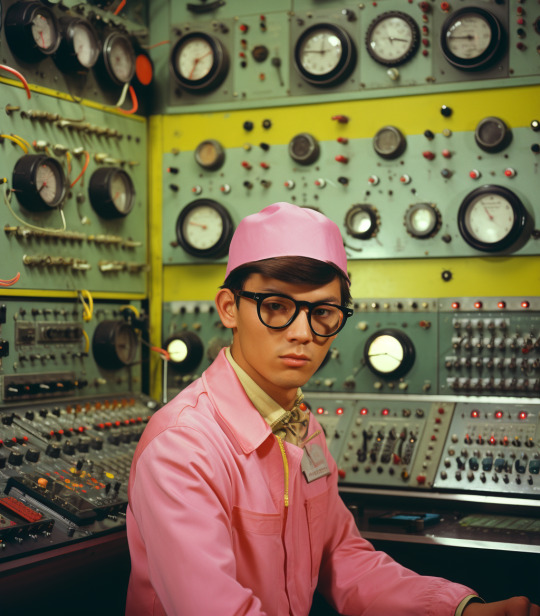


The next Plant on the tour was the Obara Nori (小原のり), a nuclear plant in the town of Hitsuragi (ヒツラギ) in the Hatsuma District (初間地区) of Toyō Prefecture (東洋県), Japan (日本). We gained entrance after the Plant’s closure in 2000; however, it was built between 1970 - 1982. The Plant featured two control rooms on either side of the facility. These rooms maintained the reactors in tandem as an added measure of security (disproved after a controversial test in 1999).
The first room consisted of many screens and reporting devices; this was the main control room, called “Kojima” (小島) by the Plant’s board and technical staff. The pastel yellow color was chosen to calm the operators in case of an unexpected accident.
The second room, named “Fujita” (藤田), served to monitor Kojima and also perform regularly safety tests on the Plant’s reactors. Together, the two control rooms created a significant balance that helped keep the Plant in check.
#wes anderson#ai image#ai artwork#aiartcommunity#worldbuilding#retromedia#retro futurism#midjourney#Wes Anderson power plants#industrial#atomic#atomic era#portrait#visual diary#retrowave#vintage aesthetic#nuclear power#nuclear#japanese
27 notes
·
View notes